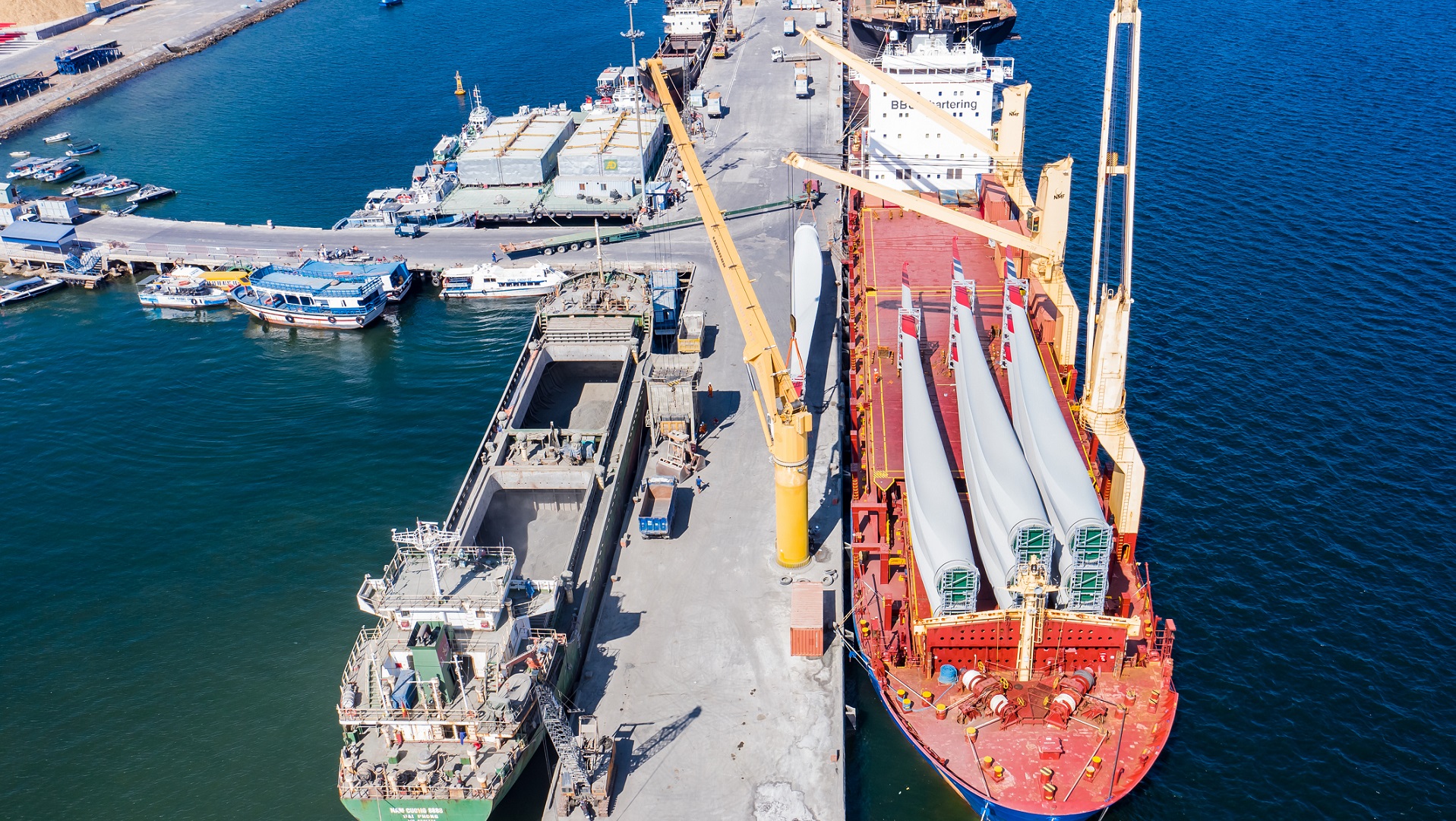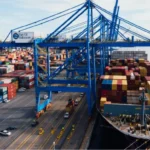Breakbulk shipping is the transportation of individual pieces of cargo. That is, the goods are separately loaded and unloaded and could be grains, timber, steel, metals, etc. Such ships are generally used for cargo that does not fit into standard containers or is unable to withstand uniform consolidation. Special equipment might be needed for the safe loading and unloading of the goods.
Importance of Breakbulk Shipping:
Breakbulk shipping has several significant advantages:
Loading Flexibility: Breakbulk shipping allows for loading various goods without the need to pack them into standard containers. Thus allowing the easy condiment of all sorts of goods.
Reduced Costs: Breakbulk shipping is generally cheaper than container shipping, as it does not require the use of specialized equipment such as containers and their associated operational costs.
Breakbulk shipping is ideal for unpacked goods such as crop commodities, raw materials, and heavy machinery which do not require specialized packing.
Faster: Sometimes breakbulk cargo can be faster than putting Volume in a standardized container, which can take time if the goods require immediate handling or if there is a need to ship them right away.
Space Efficiency: In instances where goods are impractical to containerize, breakbulk shipping enables more efficient space utilization in that more goods can be loaded onto the ship.
Moving Needs Of Irregularly Shaped Goods: The breakbulk shipping process allows huge items and irregularly shaped items like industrial equipment or heavy machinery to be moved, which is another significant reason why many industries prefer it.
Types of Cargo Transported by Breakbulk Shipping:
The transportation of goods that do not fit into standard-sized containers is called breakbulk shipping. Examples of types of breakbulk cargo include:
Grains, Agricultural Products:
- Gut: Wheat, rice, and oats.
- Agricultural goods such as leguminous seeds, cotton,n and sugar.
Raw Materials and Metals:
- These include raw materials such as coal, iron, copper, aluminum, and zinc.
Bulk Food Products:
- Bulk cargo Bulk refers to the type of goods such as vegetable oils and other liquid food products that can be transported without the use of packaging through containers.
Timber and Wood Products:
- Sawn timber, wooden boards, and wood products.
Heavy Equipment and Machinery:
- Industrial machinery, heavy machinery equipment, vehicles, and oversized spare parts.
Oversized industrial:
- components and machinery that cannot be base-loaded into regular containers.
Using RoRo Ships in Breakbulk Shipping:
Breakbulk cargo is typically transported on RoRo ships (Roll-on/Roll-off). They’re built to transport cars, heavy industrial equipment, and bulky loads that can easily be loaded and unloaded through internal ramps in the ship. This is how breakbulk moves on RoRo ships:
- Safety and Securing:
It has dedicated spaces for secure fastening and securing of breakbulk cargo on RoRo ships. Using straps, chains, and ropes to secure cargo in place is one of the many ways to secure cargo.
- Special Equipment:
The RoRo carriers are specially designed for the quick and efficient handling of breakbulk cargo, including ramps, cranes, and other equipment that can handle loading and unloading more efficiently.
- Good Storage and Arrangement:
Cargo is stowed for easy access while loading and unloading and is secured within the holds of the vessel itself.
- Environmental Monitoring:
Measuring temperature and humidity levels also helps with the safe transportation of breakbulk cargo during the trip through the ship holds.
- Logistical Planning:
Proper logistical planning for shipping and unloading processes ensures that cargo arrives on time with minimal issues and delays.
By employing these methods and procedures, breakbulk cargo can be safely and efficiently transported on RoRo ships.
Types of Shipping Methods Used in Breakbulk Shipping:
In breakbulk shipping, a few different methods are used, which can differ depending on the nature of the goods and what is needed for transport and discharge. Here are some common methods:
Manual Loading:
- In this method, cargo is loaded and unloaded by human labor or manually operated equipment only like cranes, ropes, etc. This is a common practice for smaller or lighter goods.
Use of Cranes and Lifts:
- Heavy machinery and industrial equipment are loaded and unloaded with the help of cranes and lifts. This method is being applied in the ports and terminals which have such heavy equipment.
Use of Ropes and Special Ropes:
- Ropes and special ropes are used to tie the goods tightly when loading and unloading. This is an alternative method of transportation for large and irregular-shaped goods.
Pallets and Wooden Ladders Usage:
- Pallets or wooden ladders are sometimes used to help distribute goods and loading/unloading operations.
Wearing of Straps and Iron Shackles:
- When carrying heavy and large goods that need to be secured, straps and iron shackles can be used to tie goods to the vehicle.
Risks of Bulk Cargo Transport:
However, bulk cargoes carry some unique risks:
Damage to Goods:
- It is crucial to safeguard bulk cargo against tormenting handling and severe vibrations when loading and unloading, as it can also lead to damage or destruction of the cargo, resulting in huge financial losses for the owners.
Delivery Delays:
- Such factors across bulk shipping operations can result in delays in the transportation of goods either because of adverse weather conditions or issues during loading and unloading.
Maritime Accidents:
- In the shipping business, it is normal for ships including bulk carriers, barges, and tankers to be subject to maritime hazards including marine accidents like capsizing or crashing, which cause high losses for freight or vessel owners.
Release Of Toxic Materials:
- When large quantities of hazardous materials are involved, accidental leaks from bulk transport may lead to environmental contamination or health impacts for people working in or living near shipping operations.
Logistical Challenges:
- Like with all bulk cargo, some logistics complaints may emerge with it, including the risks of storage, loading, and unloading due to their large sizes or heavy weights.
All of these methods and risks speak to the complexities of making breakbulk shipping operations happen, and the value of the right planning, judgment, and execution to avoid mishaps.
How to Reduce Risks in Breakbulk Shipping:
Safe breakbulk shipping with a standard set of preventive measures and security procedures. These actions that must be taken are:
Training and Education:
- Train staff who manage breakbulk cargo on its safe handling as per local, and international standards and regulations.
Proper Packing and Packaging:
- Packaging and pack your goods in such a way as to protect them during transporting, storing, and unloading
Use of Appropriate Transport Modes:
- Use a suitable and dependable means of breakbulk transport, and confirm that carriers are appropriately certified and licensed.
Security Regulation Compliance:
- Make sure the company obeys all local and international security rules, including general safety standards for shipping and storage.
Insurance Verification:
- Make sure your insurance coverage is high enough for breakbulk cargo to prevent any loss while on board.
Monitoring the Logistics Environment:
- Track environmental conditions, such as temperature and humidity, in real-time during shipping operations to ensure that goods remain of high quality.
Emergency Planning:
- Establish specific emergency plans in case of incidents or issues during breakbulk shipping operations.
Collaboration with Partners:
- Interact with the partners of the supply chain to maintain a smooth flow of shipping business information.










